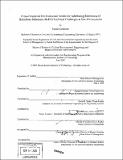Cross-functional environmental initiatives : addressing Restriction of Hazardous Substance (RoHS) technical challenges at Sun Microsystems
Author(s)
Greenlaw, Tamara
DownloadFull printable version (10.04Mb)
Other Contributors
Leaders for Manufacturing Program.
Advisor
Randall Kirchain and Sara Beckman.
Terms of use
Metadata
Show full item recordAbstract
The European Union (EU) passed the Restriction of Hazardous Substances (RoHS) Directive, effective January 2006, banning the sale of electronics equipment containing lead and five other hazardous substances into EU countries. The RoHS Directive is driving an accelerated transition to lead-free technology and products across the electronics industry. Lead is commonly used in component finishes and is a key material in the solder process used to attach components to printed circuit boards. Lead-free technical challenges include implementing significant changes in component plating and circuit board assembly. Although the industry has collaborated to produce viable technical options, various lead-free solutions have trade-offs among cost, reliability, and short-term availability. Given regulatory deadlines and potential loss of EU sales, Sun and others in the electronics industry are impelled to make material and process changes based on less data and information than they would typically act on. Sun's RoHS technical team was staffed from the Central Engineering group and developed RoHS specifications that go beyond basic compliance in order to address known lead-free reliability issues. However, lead-free requirements included in RoHS technical specifications have significant supply chain implications with respect to cost, operations, and strategy in addition to reliability impact. The technical team has the capacity to address general lead-free technology and engineering challenges, but it is not staffed to conduct broader business impact analysis. Industry supply base readiness varies widely; not all suppliers will meet RoHS deadlines and related Sun specifications. (cont.) Product reliability and cost targets vary, but components and suppliers are common to a range of products. The technical team has experienced supplier and product group push-back in response to certain reliability-driven lead-free requirements. The question of whether Sun's reliability-driven requirements should be implemented uniformly across all products has been raised. In order to address this question and support informed decisions during the transition to lead-free, the team needed to consider the broader business and operations context as well as summarize and communicate relevant technical information. This involved thinking about the impact of RoHS specifications from an operations perspective, assessing relevant industry capability and trends, considering specification modifications or alternatives that would facilitate near term implementation, and considering alignment with longer term supply chain strategy. Additionally, challenges facing the technical team highlight two ways in which the RoHS Directive is setting a precedent in the electronics industry. First, RoHS is an environmental initiative driving significant change across the industry value chain. This raises both tactical issues of how to coordinate and maintain industry consistency and efficiency, and strategic questions of when to collaborate vs. where competitive advantage may be gained. Second, within each company, RoHS impacts virtually all functional groups and cannot be implemented without broad coordination and effort. (cont.) While this is similar to non-environmental cross-functional initiatives, most companies have not dedicated resources to environmental strategy and planning, nor have they integrated environmental issues into existing functions. Thus the capability to (a) strategically assess environmental activity as an investment with potential returns, (b) proactively drive tactical environmental programs, and (c) make meaningful progress on environmental and social issues is insufficient, contributing to the firefighting nature of RoHS activity and criticism of Corporate Social Responsibility (CSR) programs. The RoHS initiative illustrates the case for investing resources in forward looking corporate environmental planning and strategy.
Description
Thesis (M.B.A.)--Massachusetts Institute of Technology, Sloan School of Management; and, (S.M.)--Massachusetts Institute of Technology, Dept. of Civil and Environmental Engineering; in conjunction with the Leaders for Manufacturing Program at MIT, 2005. Includes bibliographical references (p. 113-115).
Date issued
2005Department
Leaders for Manufacturing Program at MIT; Massachusetts Institute of Technology. Department of Civil and Environmental Engineering; Sloan School of ManagementPublisher
Massachusetts Institute of Technology
Keywords
Sloan School of Management., Civil and Environmental Engineering., Leaders for Manufacturing Program.